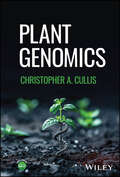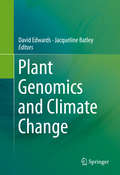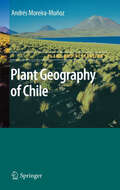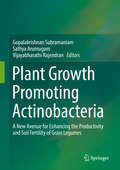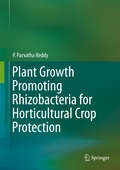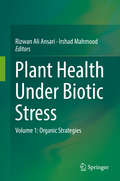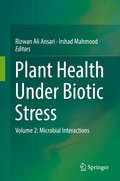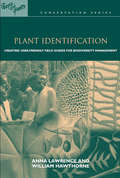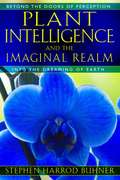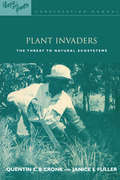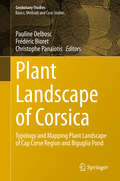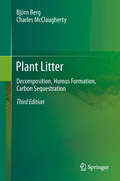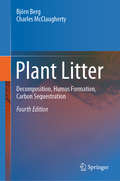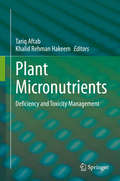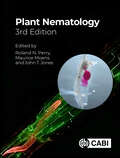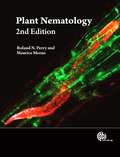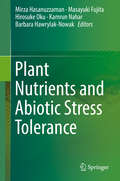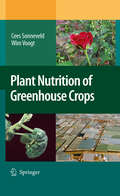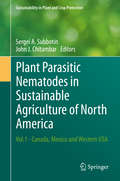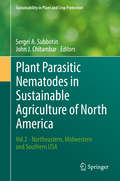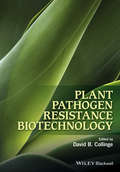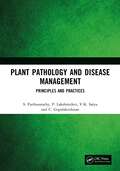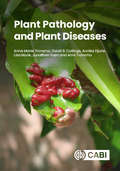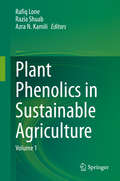- Table View
- List View
Plant Genomics
by Christopher A. CullisIntroduction to the range of molecular techniques to investigate unique facets of plant growth, development, and responses to the environment Plant Genomics introduces the complex relationship between the genome, microbiome, genes, and epigenetics of plants, as well as the range of molecular techniques applicable to investigating the unique facets of plant growth, development, and response to the environment. State-of-the-art science in the field is discussed, as well as future outlooks on what the next decade is likely to bring. This book includes new techniques for modifying the plant genome and their impact on modifying plants to combat the impact of biotic and abiotic stresses, including those associated with climate change, new technologies including long and short read sequencing and proximity ligation and the combination of these technologies for assembling sequence data into chromosomes, a new chapter on the sequences of the chloroplast and mitochondrial genomes, and a dedicated chapter to epigenetics and the importance in gene regulation. Written by a highly qualified author with significant published research contributions to the field, Plant Genomics includes information on: Structure and information content of the chloroplast and mitochondrial genomes and their use in phylogenyUse of transcriptomes from various tissues to identify expressed sequences and their identification as genesFunction of small regulatory RNAs and long non-coding RNAs and involvement of small RNAs in the control of gene expressionEpigenetic silencing of transposable elements and their release by stress and cross-generational contribution of epigenetic variation Use of the pan-genome to assemble a comprehensive germplasm for a particular crop species Plant Genomics is an ideal textbook for undergraduate courses on plant biology, particularly those focusing on molecular descriptions, and a helpful auxiliary text to plant biology laboratory courses. It will also be of interest to students in plant molecular biology, agricultural and food sciences, and plant, food, and crop bioengineering.
Plant Genomics and Climate Change
by David Edwards Jacqueline BatleyThis book explores the impact of climate change on agriculture and our future ability to produce the crops which are the foundation of the human diet. Specifically, individual chapters explore the potential for genomics assisted breeding of improved crops with greater yield and tolerance to the stresses associated with predicted climate change scenarios. Given the clear and unmet challenge to mitigate climate changing events, this book will be of wide interest from plant breeders and environmental scientists, government bodies through to a more general audience who are interested in the likely impact of climate change on agriculture.
Plant Geography of Chile
by Andres Moreira-MunozThe first and so far only Plant Geography of Chile was written about 100 years ago, since when many things have changed: plants have been renamed and reclassified; taxonomy and systematics have experienced deep changes as have biology, geography, and biogeography. The time is therefore ripe for a new look at Chile's plants and their distribution. Focusing on three key issues - botany/systematics, geography and biogeographical analysis - this book presents a thoroughly updated synthesis both of Chilean plant geography and of the different approaches to studying it. Because of its range - from the neotropics to the temperate sub-Antarctic - Chile's flora provides a critical insight into evolutionary patterns, particularly in relation to the distribution along the latitudinal profiles and the global geographical relationships of the country's genera. The consequences of these relations for the evolution of the Chilean Flora are discussed. This book will provide a valuable resource for both graduate students and researchers in botany, plant taxonomy and systematics, biogeography, evolutionary biology and plant conservation.
Plant Growth Promoting Actinobacteria
by Gopalakrishnan Subramaniam Sathya Arumugam Vijayabharathi RajendranGlobal yields of legumes have been relativelystagnant for the last five decades, despite the adoption of conventional andmolecular breeding approaches. The use of plant growth-promoting (PGP) bacteriafor improving agricultural production, soil and plant health has become one ofthe most attractive strategies for developing sustainable agriculture. Actinomycetes arebacteria that play an important role in PGP and plant protection, producesecondary metabolites of commercial interest, and their use is well documented inwheat, rice, beans, chickpeas and peas. In order to promote legumes, the general assembly ofthe UN recently declared 2016 the "International Year of Pulses. " In view ofthis development, this book illustrates how PGP actinomycetes can improve grainyield and soil fertility, improve control of insect pests and phytopathogens,and enhance host-plant resistance. It also addresses special topics of currentinterest, e. g. the role of PGP actinomycetes in the biofortification of legumeseeds and bioremediation of heavy metals.
Plant Growth Promoting Rhizobacteria for Horticultural Crop Protection
by P. Parvatha ReddyThe use of synthetic pesticides has undoubtedly resulted in the achievement of increased crop production. However, in recent times, there has been a considerable pressure on consumers and farmers to reduce or eliminate the use of synthetic pesticides in horticulture, since fruits and vegetables are consumed afresh. This concern has encouraged looking for better alternatives which are cheaper and eco-friendly than synthetic pesticides. It is well known that plant growth promoting rhizobacteria (PGPR) play an important role in maintaining crop and soil health through versatile mechanisms. There are two main outcomes or effects from beneficial microorganisms: enhanced plant growth and crop protection, both of which represent the two main constraints to agriculture. The information on biomanagement of pests (insect and nematode pests, fungal, bacterial and viral/phytoplasma diseases) of horticultural crops (fruits, vegetables, plantation, spice, tuber, ornamental, medicinal and aromatic crops) using PGPR is very much scattered. There is no book at present which comprehensively and exclusively deals with the above aspects on horticultural crops. The present book deals with biomanagement of pests in horticultural crops in detail using PGPR. The present book deals with biomanagement of pests in horticultural crops in detail using PGPR. The present book is divided into six sections. The first section deals with the importance of PGPR including introduction, potential role of PGPR in agriculture, genera of PGPR, disease management, nematode management, insect pest management, integrated pest management, mechanism of biocontrol, mass production, formulation, delivery and commercialization. Pest management in tropical, sub-tropical and temperate fruit crops is dealt in Section II. The third section deals with pest management in Solanaceous, bulbous, Malvaceous, Cruciferous, Leguminous, Cucurbitaceous, leafy and root and tuber vegetable crops. Pest management in plantation and spice crops is in Section IV. Section V deals with pest management in ornamental, medicinal and aromatic crops. The last section deals with a road map ahead including challenges, future prospective and conclusions. The book is extensively illustrated with excellent quality photographs enhancing the quality of publication. The book is written in lucid style, easy to understand language along with adoptable recommendations involving eco-friendly components of IPM.
Plant Health Under Biotic Stress: Volume 1: Organic Strategies
by Rizwan Ali Ansari Irshad MahmoodThe current scenario of increasing sensitivity towards the sustainable agriculture has given a large space to extensively utilize natural resources that are environmental friendly and are a good replacement of chemicals in agriculture. Application of organic additives in the sustainable disease management can provide new insight in sustenance of plant productivity along with improved host stress tolerance. In the present book we have focussed upon a range of organic strategies to control plant pathogens of wide spectrum in addition to maintaining robust plant health. A detailed account on the application of organic additives has been discussed, irrespective of their origin and nature. In addition, the methods of utilising these organic supplements in the management of plant diseases and promotion of plant yield in more economic way have also been presented with reference to developing, underdeveloped and developed countries. The book has included the works of eminent scholars from across the world thus flashing light on the key literature related to application of organic matters including phytoextracts, chopped leaves, composted organic manures and liquid manures in eco-friendly agriculture. The mechanisms underlying the effectiveness of these organic amendments in promoting plant health has also been presented and discussed in understandable ways.
Plant Health Under Biotic Stress: Volume 2: Microbial Interactions
by Rizwan Ali Ansari Irshad MahmoodThe book illustrates the use of putative microbial agents which provide good protection to the plant from biotic pathogens attack. An up to date knowledge on plant-microbiome interaction strategies in terms of improved sustainability has been discussed. Information from experts across the globe on the application of microbes for providing amicable solution in sustainable agriculture has been gathered. In addition, information related to microbes mediated resistance levels leading to enhanced plant health has been well presented. The chapters have emphasised the use of Plant Growth Promoting Rhizobacteria (PGPR) and other potential biocontrol agents/antagonists in the management of plant diseases which provide extensive information to the readers. Literature on microbial root colonization, plant growth promotions, and also on the protection of plants from attack of various soil borne pathogens have been presented in a coherent way. Information on the application of potential strain of the bio-control fungi, endophytes, actinomycetes strengthening the plants ability which rescue the plant from pathogens attack leading to improved plant health has also been underpinned.
Plant Identification: Creating User-Friendly Field Guides for Biodiversity Management
by Anna Lawrence William HawthorneAn important prerequisite for successful conservation is a good understanding of what we seek to conserve. Nowhere is this more the case than in the fight to protect plant biodiversity, which is threatened by human activity in many regions worldwide. This book is written in the belief that tools that enable more people to understand biodiversity can not only aid protection efforts but also contribute to rural livelihoods. Among the most important of those tools is the field guide. Plant Identification provides potential authors of field guides with practical advice about all aspects of producing user-friendly guides which help to identify plants for the purposes of conservation, sustainable use, participatory monitoring or greater appreciation of biodiversity. The book draws on both scientific and participatory processes, supported by the experience of contributors from across the tropics. It presents a core process for producing a field guide, setting out key steps, options and techniques available to the authors of a guide and, through illustration, helps authors choose methods and media appropriate to their context.
Plant Intelligence and the Imaginal Realm: Beyond the Doors of Perception into the Dreaming of Earth
by Stephen Harrod BuhnerA manual for opening the doors of perception and directly engaging the intelligence of the Natural World • Provides exercises to directly perceive and interact with the complex, living, self-organizing being that is Gaia • Reveals that every life form on Earth is highly intelligent and communicative • Examines the ecological function of invasive plants, bacterial resistance to antibiotics, psychotropic plants and fungi, and the human species In Plant Intelligence and the Imaginal Realm, Stephen Harrod Buhner reveals that all life forms on Earth possess intelligence, language, a sense of I and not I, and the capacity to dream. He shows that by consciously opening the doors of perception, we can reconnect with the living intelligences in Nature as kindred beings, become again wild scientists, nondomesticated explorers of a Gaian world just as Goethe, Barbara McClintock, James Lovelock, and others have done. For as Einstein commented, “We cannot solve the problems facing us by using the same kind of thinking that created them.” Buhner explains how to use analogical thinking and imaginal perception to directly experience the inherent meanings that flow through the world, that are expressed from each living form that surrounds us, and to directly initiate communication in return. He delves deeply into the ecological function of invasive plants, bacterial resistance to antibiotics, psychotropic plants and fungi, and, most importantly, the human species itself. He shows that human beings are not a plague on the planet, they have a specific ecological function as important to Gaia as that of plants and bacteria. Buhner shows that the capacity for depth connection and meaning-filled communication with the living world is inherent in every human being. It is as natural as breathing, as the beating of our own hearts, as our own desire for intimacy and love. We can change how we think and in so doing begin to address the difficulties of our times.
Plant Invaders: The Threat to Natural Ecosystems (People and Plants International Conservation #Vol. 1)
by Quentin C.B. Cronk Janice L. FullerA practical guide to the protection and management of ecosystems against invasions by non-indigenous plant species. The authors seek to offer an accessible account of the subject and how to protect natural habitats. The majority of countries suffer from invasive plants and there are case studies from North America, Europe, Australia, South and South East Asia and the Pacific and Atlantic islands. There is also a list of invasive species, with their countries of origin and regions of introduction.
Plant Landscape of Corsica: Typology and Mapping Plant Landscape of Cap Corse Region and Biguglia Pond (Geobotany Studies)
by Pauline Delbosc Frédéric Bioret Christophe PanaïotisSince the 1970s and particularly the works of Tüxen (1978) and Géhu & Rivas-Martínez (1981), dynamico-catenal phytosociology has facilitated the integration of vegetation dynamics by more precisely describing the trajectories of vegetation series. A national habitat mapping program (CarHAB), launched by France’s Ministry of Ecology, aims to map the vegetation and vegetation series of metropolitan France at a scale of 1: 25,000 by 2025. In this context, Corsica has been selected as a pilot region, due to its unique characteristics regarding Mediterranean and alticole vegetation. This book describes in detail the vegetation series and geoseries (ecology, structure, dynamic trajectories, effects of anthropogenic factors on vegetation dynamics, catenal positioning in the landscape) of two Corsican sectors: Cap Corse and Biguglia pond. These two study sites were selected using two methods: • For Cap Corse, the typology and mapping are based on an inductive approach, which seeks to understand the dynamics of vegetation by drawing on the mature, substitutional, pioneering and anthropogenic associations likely to exist within a tessellar envelope. These various dynamic stages characterize “the vegetation series” (sigmetum or synassociation), the fundamental unit of symphytosociology (Géhu 2006; Biondi 2011). The aim of symphytosociology is, therefore, to define the vegetation series; in other words, it seeks to identify the repetitive combinations of syntaxa under homogeneous ecological conditions. • For Biguglia pond, the typology and mapping are based on a deductive approach, which combines (under SIG) the ecological descriptor maps with the vegetation mapping, in order to reveal the tesselas and the natural potential vegetation that underlies them. Thanks to the improvement of GIS techniques, this approach has been frequently used to characterize plant landscapes from vegetation to vegetation geoseries since the 2000s, with applications to the conservation management of natural and semi-natural environments.
Plant Life: The Entangled Politics of Afforestation
by Rosetta S. ElkinHow afforestation reveals the often-concealed politics between humans and plantsIn Plant Life, Rosetta S. Elkin explores the procedures of afforestation, the large-scale planting of trees in otherwise treeless environments, including grasslands, prairies, and drylands. Elkin reveals that planting a tree can either be one of the ultimate offerings to thriving on this planet, or one of the most extreme perversions of human agency over it. Using three supracontinental case studies—scientific forestry in the American prairies, colonial control in Africa&’s Sahelian grasslands, and Chinese efforts to control and administer territory—Elkin explores the political implications of plant life as a tool of environmentalism. By exposing the human tendency to fix or solve environmental matters by exploiting other organisms, this work exposes the relationship between human and plant life, revealing that afforestation is not an ecological act: rather, it is deliberately political and distressingly social. Plant Life ultimately reveals that afforestation cannot offset deforestation, an important distinction that sheds light on current environmental trends that suggest we can plant our way out of climate change. By radicalizing what conservation protects and by framing plants in their total aliveness, Elkin shows that there are many kinds of life—not just our own—to consider when advancing environmental policy.
Plant Litter
by Björn Berg Charles McclaughertySince the publication of the 2nd edition, there have been substantial developments in the field of litter decomposition. This fully revised and updated 3rd edition of Plant Litter reflects and discusses new findings and re-evaluates earlier ones in light of recent research and with regard to current areas of investigation. The availability of several long-term studies allows a more in-depth approach to decomposition patterns and to the later stages of decomposition, as well as to humus formation and accumulation. The latest information focuses on three fields: - the effects of manganese on decomposition and possibly on carbon sequestration, - new findings on decomposition dynamics, and - the new analytical technique using 13C-NMR.
Plant Litter: Decomposition, Humus Formation, Carbon Sequestration
by Björn Berg Charles McClaughertyThis book gives basic facts about litter decomposition studies, which are of guidance for scientists who start studies. Since the publication of the third edition, there has been quite a development not only in the field of litter decomposition but also in supporting branches of science, which are important for fruitful work on and understanding of decomposition of plant litter and sequestration of carbon. A consequence is that ‘old established truths’ are becoming outdated. New knowledge in the fields of phytochemistry and microbial ecology has given a new baseline for discussing the concepts ‘litter decomposition’ and ‘carbon sequestration’. We can also see a rich literature on litter decomposition studies using roots and wood as substrates. These have given new insights in factors that regulate the decomposition rate and as regards roots their contribution to sequestered carbon in humus. Additional facts on the role of temperature vs the litters’ chemical composition may in part change our view on effects of climate change. Further information on applications of the new analytical technique (13C-NMR) for determining organic-chemical compounds has allowed us to develop these parts. Focus is laid on needle litter of Scots pine as a model substrate as this species has been considerably more studied than other litter species. Also the boreal/northern temperate coniferous forest has in part been given this role. Still, new information may allow us to develop information about litter from further tree species.
Plant Micronutrients: Deficiency and Toxicity Management
by Khalid Rehman Hakeem Tariq AftabPlants require essential nutrients (macronutrients and micronutrients) for normal functioning. Sufficiency range is the levels of nutrients necessary to meet the plant’s needs for optimal growth. This range depends on individual plant species and the particular nutrient. Nutrient levels outside of a plant’s sufficiency range cause overall crop growth and health to decline, due either to deficiency or toxicity from over-accumulation. Apart from micronutrients (B, Cl, Mn, Fe, Zn, Cu and Mo), Aluminum (Al), cerium (Ce), cobalt (Co), iodine (I), lanthanum (La), sodium (Na), selenium (Se), silicon (Si), titanium (Ti), and vanadium (V) are emerging as novel biostimulants that may enhance crop productivity and nutritional quality. These beneficial elements are not "essential" but when supplied at low dosages, they augment plant growth, development, and yield by stimulating specific molecular, biochemical, and physiological pathways in responses to challenging environments.The book is the first reference volume that approaches plant micronutrient management with the latest biotechnological and omics tools. Expertly curated chapters highlight working solutions as well as open problems and future challenges in plant micronutrient deficiency or toxicity. We believe this book will introduce readers to state-of-the-art developments and research trends in this field.
Plant Nematology
by Maurice Moens Roland N. Perry John T. JonesPlant-parasitic nematodes are a major threat to crop production in all countries, and identification of nematodes and knowledge of their biology is of paramount importance. Providing a broad introduction to nematodes as plant parasites, this book begins by describing nematodes by genera, and then builds on this foundation to detail nematode biology and pest management, including resistance, and biological and chemical control. This 3rd edition is updated to address advances in our knowledge of plant-parasitic nematodes, particularly concerning the molecular aspects of host-parasite relationships, including the application of genomics to nematode biology. Changes in control and management strategies are also covered. The influence of climate change on plant-parasitic nematodes is addressed in a new chapter on ecology. Primarily aimed at students (MSc and PhD), this book is also invaluable for researchers and lecturers in nematology, plant pathology and parasitology, advisory and quarantine services, and crop protection scientists.
Plant Nematology
by Maurice Moens Roland N Perry* Fully updated to take account of the most recent research * Chapters are written by international experts and enhanced by extensive illustrations and focus boxes * Divided into three sections for ease of use
Plant Nutrients and Abiotic Stress Tolerance
by Masayuki Fujita Mirza Hasanuzzaman Hirosuke Oku Kamrun Nahar Barbara Hawrylak-NowakThis book discusses many aspects of plant-nutrient-induced abiotic stress tolerance. It consists of 22 informative chapters on the basic role of plant nutrients and the latest research advances in the field of plant nutrients in abiotic stress tolerance as well as their practical applications. Today, plant nutrients are not only considered as food for plants, but also as regulators of numerous physiological processes including stress tolerance. They also interact with a number of biological molecules and signaling cascades. Although research work and review articles on the role of plant nutrients in abiotic stress tolerance have been published in a range of journals, annual reviews and book chapters, to date there has been no comprehensive book on this topic. As such, this timely book is a valuable resource for a wide audience, including plant scientists, agronomists, soil scientists, botanists, molecular biologists and environmental scientists.
Plant Nutrition of Greenhouse Crops
by Wim Voogt Cees SonneveldGreenhouse cultivation is noted for its high uptake of minerals, consistent climatic conditions, exclusion of natural precipitation and control of salt accumulation. Acknowledging that plant nutrition in greenhouse cultivation differs in many essentials from field production, this volume details specific information about testing methods for soils and substrates in a greenhouse environment. It does so while offering a universally applicable analysis. This is based on the composition of the soil and substrate solutions, methods for the interpretation of tissue tests, and crop responses on salinity and water supply in relation to fertilizer application. Fertilizer additions, related to analytical data of soil and substrate samples, are presented for a wide range of vegetable and ornamental crops. The subject is especially apt now as substrate growing offers excellent possibilities for the optimal use of water and nutrients, as well as the potential for sustainable production methods for greenhouse crops.
Plant Parasitic Nematodes in Sustainable Agriculture of North America: Vol. 1 - Canada, Mexico And Western Usa (Sustainability In Plant And Crop Protection Ser.)
by Sergei A. Subbotin John J. ChitambarPlant-parasitic nematodes are recognized as one of the greatest threats to crop production throughout the world. Estimated annual crop losses of $8 billion in the United States and $78 billion worldwide are attributed to plant parasitic nematodes. Plant parasitic nematodes not only cause damage individually but form disease-complexes with other microorganisms thereby increasing crop loss. Nematode diseases of crops are difficult to control because of their insidious nature and lack of specific diagnostic symptoms which closely resemble those caused by other plant pathogens and abiotic diseases. Future developments of sustainable management systems for preventing major economical agricultural losses due to nematodes is focused on strategies that limit production costs, enhance crop yields, and protect the environment. This book presents a first compendium and overview for nematode problems and their management across North America. Each chapter provides essential information on the occurrence and distribution of plant parasitic nematodes, their major crop hosts, impact on crop production and sustainable management strategies for each region of the continent including, Canada, Mexico and all states of the USA. For each region, a thematic overview of changes in crop production affected by plant parasitic nematodes and their management strategies over time will provide invaluable information on the important role of plant parasitic nematodes in sustainable agriculture.
Plant Parasitic Nematodes in Sustainable Agriculture of North America: Vol. 1 - Canada, Mexico And Western Usa (Sustainability In Plant And Crop Protection Ser.)
by Sergei A. Subbotin John J. ChitambarPlant-parasitic nematodes are recognized as one of the greatest threats to crop production throughout the world. Estimated annual crop losses of $8 billion in the United States and $78 billion worldwide are attributed to plant parasitic nematodes. Plant parasitic nematodes not only cause damage individually but form disease-complexes with other microorganisms thereby increasing crop loss. Nematode diseases of crops are difficult to control because of their insidious nature and lack of specific diagnostic symptoms which closely resemble those caused by other plant pathogens and abiotic diseases. Future developments of sustainable management systems for preventing major economical agricultural losses due to nematodes is focused on strategies that limit production costs, enhance crop yields, and protect the environment. This book presents a first compendium and overview for nematode problems and their management across North America. Each chapter provides essential information on the occurrence and distribution of plant parasitic nematodes, their major crop hosts, impact on crop production and sustainable management strategies for each region of the continent including, Canada, Mexico and all states of the USA. For each region, a thematic overview of changes in crop production affected by plant parasitic nematodes and their management strategies over time will provide invaluable information on the important role of plant parasitic nematodes in sustainable agriculture.
Plant Pathogen Resistance Biotechnology
by David CollingePlant pathogens and diseases are among the most significant challenges to survival that plants face. Disease outbreaks caused by microbial or viral pathogens can decimate crop yields and have severe effects on global food supply. Understanding the molecular mechanisms underlying plant immune response and applying this understanding to develop biotechnological tools to enhance plant defense against pathogens has great potential for moderating the impact of plant disease outbreaks. Plant Pathogen Resistance Biotechnology's main focus is an in depth survey of the biological strategies being used to create transgenic disease resistant plants for sustainable plant resistance Plant Pathogen Resistance Biotechnology is divided into four sections. The first section covers biological mechanisms underpinning disease resistance in plants, while the second highlights case studies of important pathogen-crop groups and then considers why the application of important pathogen-crop groups, transgenic-based strategies designed to selectively target pathogens could benefit crop production. The third section provides information on the status of transgenic crops around the world, and finally the last part explores high-tech alternatives to genetic engineering for developing disease resistant traits in plants. Edited and authored by leaders in the field, Plant Pathogen Resistance Biotechnology will be an invaluable resource to those studying or researching plant biotechnology, plant pathology, plant biology, plant and crop genetics, in addition to crop science.
Plant Pathology and Disease Management: Principles and Practices
by S. Parthasarathy C. Gopalakrishnan P. Lakshmidevi V.K. SatyaThis book introduces the nature, causes and impact of plant diseases. It briefly describes the history of plant pathology as a scientific discipline and introduces the disease cycle as the key tool for understanding disease development and devising appropriate management strategies. It addresses the mechanisms of pathogenicity and immunity. It explores the biology of the interactions between plants and plant pathogens from the cellular level to the population level, with the chapter addressing epidemiology. The book then concerns the approaches we can take to alleviate the effects of plant pathogens. Print edition not for sale in India.
Plant Pathology and Plant Diseases
by Anne Marte Tronsmo David B Collinge Annika Djurle Lisa Munk Jonathan Yuen Arne TronsmoThis textbook provides a comprehensive introduction to all aspects of plant diseases, including pathogens, plant-pathogen interactions, their management, and future perspectives. Plant diseases limit potential crop production and are responsible for considerable losses in agriculture, horticulture and forestry. Our global food production systems are under increasing pressure from global trade, climate change and urbanization. If we could alleviate the losses due to plant diseases, we would be able to produce roughly 20% more food - enough to feed the predicted world population in 2050. Co-authored by a group of international teachers of plant pathology who have collaborated for many years, the book gives expert and seamless coverage. Plant Pathology and Plant Diseases: Addresses major advances in plant-pathogen interactions, classification of plant pathogens, and the methods of managing or controlling disease Is relevant for a global audience; it covers many examples of diseases with an impact worldwide but with an emphasis on disease of particular importance in a temperate context Features over 400 striking figures and colour photographs It is suitable for graduate students and advanced undergraduates studying plant pathology, biology, agriculture and horticulture.
Plant Phenolics in Sustainable Agriculture: Volume 1
by Rafiq Lone Razia Shuab Azra N. KamiliThis book presents the latest research on plant phenolics, offering readers a detailed, yet comprehensive account of their role in sustainable agriculture. It covers a diverse range of topics, including extraction processes; the role of plant phenolics in growth and development; plant physiology; post-harvesting technologies; food preservation; environmental, biotic and abiotic stress; as well as nutrition and health. Further the book provides readers with an up-to-date review of this dynamic field and sets the direction for future research. Based on the authors’ extensive experience and written in an engaging style, this highly readable book will appeal to scholars from various disciplines. Bringing together work from leading international researchers, it is also a valuable reference resource for academics, researchers, students and teachers wanting to gain insights into the role of plant phenolics in sustainable agriculture.
